|
Books Should Be Free Loyal Books Free Public Domain Audiobooks & eBook Downloads |
|
|
Books Should Be Free Loyal Books Free Public Domain Audiobooks & eBook Downloads |
|
Top Authors |
|---|
|
Book type:
Sort by:
|
By: Gustave Flaubert (1821-1880) | |
|---|---|
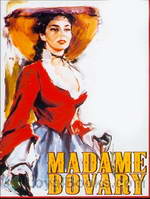 Madame Bovary
Madame Bovary
The strands woven together in Gustave Flaubert's famous, path breaking 1856 novel Madame Bovary include a provincial town in Normandy, France, a shy young doctor with an indifferent career and a lovely young woman who lives in a fantasy world based on the innumerable romantic novels she reads. Of course there is also the story of a dull marriage punctuated by passionate, adulterous love affairs. First published in serial form in a Parisian magazine and deemed to be the “perfect” novel, Flaubert's debut was received by both readers and critics with acclaim and admiration... | |
 Three Short Works
Three Short Works
Here is a collection of strikingly different pieces by Flaubert: a prose poem in the voices of Death, Satan and Nero; the trials and apotheosis of a medieval saint; and the life of a selfless maid in 19th century France. Each exhibits the vigorous exactness, and the mixture of realism and romanticism, for which Flaubert is renowned. | |
 Salammbô
Salammbô
After completing the famous Mme Bovary, Flaubert put all his efforts into researching the Punic Wars and completed the lesser known Salammbô. In this volume, Flaubert describes in detail the Mercenary Revolt and the fight of the Mercenaries against the all-powerful Carthage, the theft of the magical Zaimph and the love and hate between the Carthaginian princess Salammbô and the fiercest leader of the Mercenaries, Matho. | |
 Sentimental Education, Volume II The History of a Young Man
Sentimental Education, Volume II The History of a Young Man
| |
 Madame Bovary A Tale of Provincial Life
Madame Bovary A Tale of Provincial Life
| |
 A Simple Soul
A Simple Soul
| |
 Sentimental Education Vol 1
Sentimental Education Vol 1
| |
 The Temptation of St. Antony or A Revelation of the Soul
The Temptation of St. Antony or A Revelation of the Soul
| |
 Bouvard and Pécuchet A Tragi-comic Novel of Bourgeois Life
Bouvard and Pécuchet A Tragi-comic Novel of Bourgeois Life
| |
 Herodias
Herodias
| |
 Over Strand and Field
Over Strand and Field
| |
By: John Donne (1572-1631) | |
|---|---|
 Devotions upon Emergent Occasions
Devotions upon Emergent Occasions
Devotions upon Emergent Occasions is a 1624 prose work by the English writer John Donne. It is a series of reflections that were written as Donne recovered from a serious illness, believed to be either typhus or relapsing fever. (Donne does not clearly identify the disease in his text.) The work consists of twenty-three parts describing each stage of the sickness. Each part is further divided into a Meditation, an Expostulation, and a Prayer. The seventeenth meditation is perhaps the best-known part of the work... | |
 Letters to Severall Persons of Honour
Letters to Severall Persons of Honour
| |
By: Honoré de Balzac (1799-1850) | |
|---|---|
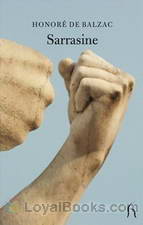 Sarrasine
Sarrasine
Published by Honoré de Balzac in the tempestuous year of 1830, the tale follows the undulating pathways of Sarrasine the sculptor’s shocking journey to his coming of age. As one of the “fathers of realism” Balzac painted with his words a vivid portrait of life in the swirling salons of Europe at the end of the Bourbon monarchy, and we follow Sarrasine from France to Italy in search of both his métier and his muse.However it is also the story of La Zambinella, an Italian singer with whom Sarrasine falls madly and passionately in love. But that passion holds a secret which Sarrasine spies too late. | |
 The Girl with the Golden Eyes
The Girl with the Golden Eyes
"Give me a feast such as men give when they love," she said, "and whilst I sleep, slay me..."Listeners who like to plunge straight into a story would do well to skip the lengthy preamble. Here, Balzac the virtuoso satirist depicts the levels of Parisian society as a version of the Inferno of Dante - but perhaps keeps the reader waiting too long for the first act of his operatic extravaganza.Our beautiful, androgynous hero, Henri de Marsay, is one of the bastard offspring of a depraved Regency milord and himself practises the cynical arts of the libertine... | |
 Farewell
Farewell
In his startling and tragic novella Farewell (‘Adieu’), Balzac adds to the 19th century’s literature of the hysterical woman: sequestered, confined in her madness; mute, or eerily chanting in her moated grange. The first Mrs Rochester lurks in the wings; the Lady of Shalott waits for the shadowy reflection of the world outside to shatter her illusion. Freud’s earliest patients will soon enter the waiting-room in their turn. Whilst out hunting two friends come across a strange waif-like woman shut up in a decaying chateau which one of them dubs “the Palace of the Sleeping Beauty”... | |
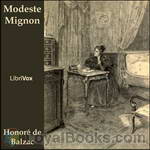 Modeste Mignon
Modeste Mignon
Modeste Mignon, a young provincial woman of romantic temperament, imagines herself to be in love with the famous Parisian poet Melchior de Canalis. However, he is not moved by her attentions. He invites his secretary Ernest de la Brière to "deal with the matter". Ernest answers Modeste's letters in his name and acts as her lover, disguised as Canalis. The scene changes dramatically when Ernest discoveres that Modest is, in fact, a rich heiress. Would he be able to win her heart despite his lie? | |
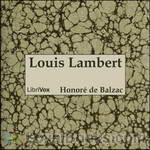 Louis Lambert
Louis Lambert
Louis Lambert is an 1832 novel by French novelist and playwright Honoré de Balzac (1799–1850), included in the Études philosophiques section of his novel sequence La Comédie humaine. Set mostly in a school at Vendôme, it examines the life and theories of a boy genius fascinated by the Swedish philosopher Emanuel Swedenborg (1688–1772). Balzac wrote Louis Lambert during the summer of 1832 while he was staying with friends at the Château de Saché, and published three editions with three different titles... | |
 Father Goriot
Father Goriot
One of Balzac's most popular works, set around 1815 during the re-ascendancy of the Bourbon kings following the defeat of Napoleon. Said to have been an inspiration to Charles Dickens and Henry James as well as others, the novel seeks to portray the realism of scenes and people. It is also a commentary upon the changing social strata and mores of the day. | |
 The Unknown Masterpiece 1845
The Unknown Masterpiece 1845
| |
 Eugénie Grandet
Eugénie Grandet
Eugénie Grandet, first published in 1833, is one of Honoré de Balzac's finest novels, and one of the first works in what would become his large novel series titled La Comédie Humaine. Set in a provincial town in post-Revolutionary France, the story deals with money, avarice, love, and obsession. A wealthy old miser must manage the passion of his innocent daughter, who later has to navigate on her own the treacherous ways of a world in which money is "the only god." Balzac's meticulous use of psychological and physical detail influenced the development of 19th-century literary realism, in the hands of writers such as Dickens, Dostoyevsky, Flaubert, and Henry James. | |
 Magic Skin
Magic Skin
Something along the lines of Dorian Gray as part of the Comedies Humane Philosophique, this is Balzac's first successful novel. He even wrote "criticisms" of the writing himself in promotion of the book, in addition to hyping the work before it even came out. It is a criticism of materialism and French bourgeoisie as so many of his compiled works seek to be. Some same characters reappear. | |
 Cousin Betty
Cousin Betty
Cousin Betty (La Cousine Bette), published in serial format in 1846, was one of the last and greatest of Balzac's works. It was part of his long novel collection titled La Comédie Humaine. Set in mid-19th-century France, it tells the story of a woman who resents her position as a "poor relation." As we follow her schemes to bring ruin upon the more privileged members of her family, we see a society in transition. The stability and idealism of the old order give way to a new bourgeois world in which virtue is strangled in the struggle for power and money... | |
 Droll Stories
Droll Stories
| |
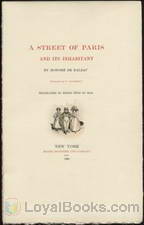 The Works Of Balzac
The Works Of Balzac
| |
 The Human Comedy: Introductions and Appendix
The Human Comedy: Introductions and Appendix
| |
 Lost Illusions
Lost Illusions
| |
 Cousin Pons
Cousin Pons
Cousin Pons is one of the final works in Balzac's long novel series titled The Human Comedy. It was published in 1847, along with Cousin Betty, as one of a complementary pair of novels, collectively titled Poor Relations. While Cousin Betty tells the story of a bitter woman who seeks revenge on her wealthier relations, in Cousin Pons, Balzac turns to the story of an timid, innocent man who is exploited and victimized by the wealthier members of his extended family.Balzac offers probing character portraits and an indictment of greed and materialism in this detailed portrait of mid-19th-century French life... | |
 Catherine De Medici
Catherine De Medici
| |
 A Woman of Thirty
A Woman of Thirty
| |
 At the Sign of the Cat & Racket
At the Sign of the Cat & Racket
| |
 The Lily of the Valley
The Lily of the Valley
| |